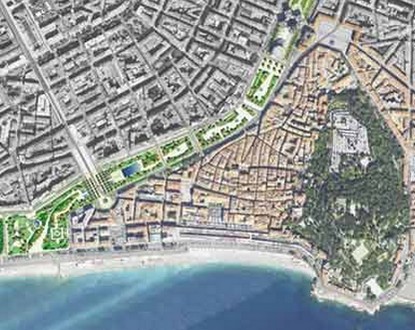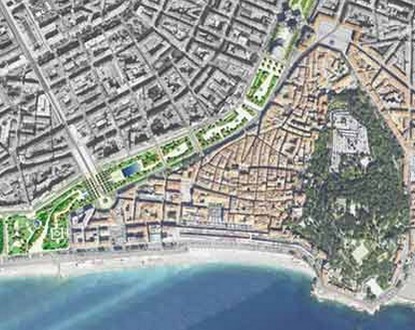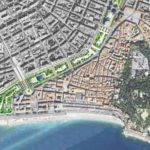As the municipal elections approach, the professional organization for landscaping companies (UNEP) publishes a ranking of the greenest cities in France. Objective: To show that the importance given to landscaping is a hot topic and that the 21st-century city should no longer pit concrete against greenery. However, this issue must become a mobilizing factor during the elections…
 Here is the UNEP ranking: 1 Angers, 2 Nantes, 3 Limoges, 4 Lyon, 5 Metz, 6 Brest, 7 Amiens, 8 Reims, 9 Nancy, 10 Strasbourg. We regret to find that Nice does not feature in the Top 10 of the general ranking, nor in any of the partial rankings.
Here is the UNEP ranking: 1 Angers, 2 Nantes, 3 Limoges, 4 Lyon, 5 Metz, 6 Brest, 7 Amiens, 8 Reims, 9 Nancy, 10 Strasbourg. We regret to find that Nice does not feature in the Top 10 of the general ranking, nor in any of the partial rankings.
A societal and environmental issue
For Catherine Muller, president of UNEP, the message is clear: “The reintroduction of nature in the city is an incredible opportunity that elected officials must seize. They should change their perspective on green spaces: see them as an investment, not an expense, and make vegetation the backbone of urban development, from the design phase.”
For UNEP, green spaces can no longer be considered merely decorative elements today: authentic public assets, they are factors of well-being and social connection. “Studies show that they are also useful investments to improve the health of our citizens,” adds Catherine Muller.
The rankings published on February 19th are based on the analysis of more than 1,500 extensive data, ranging from the municipal budget allocated to landscaping, the existence of a “biodiversity” plan at the city level, or encouragement for composting.
The 50 largest cities in France (according to the number of inhabitants, INSEE census, 2013 figures) were closely examined using public data and declarative questionnaires completed by the “Green Spaces” services of the respective cities.
Results? The cities located north of a Bordeaux-Lyon axis are the most committed, whether in terms of urban green heritage development, biodiversity, or enhancement. The Pays de la Loire region takes the top spots with Angers and Nantes (followed by Limoges) leading the greenest cities in France.
Let’s look at this in more detail based on the five main assessment criteria.
Accessible Green Heritage
In which cities do we find the most greenery? Answer: Angers, Limoges, and Brest, where the green infrastructures are “remarkable” according to UNEP, which cites 300 hectares of continuous green spaces in Angers (St Nicolas Park, Balzac Park, and Lac de Maine), 700 hectares of natural spaces (forest and meadow) in Limoges, and in Brest, the harbor road and its green and blue belt covering over 4,000 hectares.
Green Heritage
Note: the density of green spaces per inhabitant varies enormously across cities. “It ranges from 3 to 60 m² per inhabitant (and even 200 m² for Besançon, a record in France). The least well-off cities are generally located in southern regions. On average, large French cities have 11 trees per hectare (but only 0.2 trees per inhabitant…) and 31 m² of green spaces per inhabitant,” specifies UNEP.
Investment Efforts for Vegetation
Investment differences in the maintenance and creation of green spaces are vast from one city to another. The average investment of the 50 largest French cities is €47 per inhabitant (a typical example is Montpellier), but “the investment effort to create new green spaces or reorganize the existing ones varies by a factor of x50 depending on the cities,” highlights the UNEP study.
Vegetation Investment
Note: low investment can be justified for well-equipped municipalities, which then focus on maintenance (Nantes, Rennes, Metz). Others opt for innovation to create greenery in a high-density urban context, promoting green roofs (like in Lille) or green walls (Rennes), knowing that Marseille has the largest area of green roofs in the city (more than 1 hectare installed to date).
Biodiversity
Note: eco-grazing (which involves replacing gasoline mowers with sheep or cows) has already attracted eleven major cities “that are already successfully experimenting with it, especially in the great West.”
And what about the elected officials? UNEP estimates that our society’s view on biodiversity has changed, with projects contributing to ecological continuity across cities.
Green Waste Management
Green waste is an appreciable resource when you know how to optimize its value: recovered, shredded, transformed into compost, or even “methanized” to be used as an energy source, there is no shortage of solutions, underscores UNEP, for whom cities are competing with initiatives.
Green Waste
Note: In Brest, composters have been distributed to associations and individuals, in Nantes, the city offers composting training by a professional, and in Nancy, the city has adapted its urban furniture to “signal” collection points to the public. As for Metz, it has specialized in developing composters at the foot of collective buildings.
The last criterion evaluated in the ranking: the use of green spaces as an attractiveness lever. For UNEP, “Angers stands out as the true ‘landscape capital’ in France, with the Expression Gardens festival and the proximity of the Terra Botanica amusement park. But Nantes is not far behind with its Rose Biennial and Plant Madness, or the Flower Shows in Nantes, not to mention the Horticulture Garden in Reims.
Vegetation Promotion
Note: the shape of a park is essential. “If linear, it will be considered a mere passageway and will therefore be less frequented; conversely, if it forms a circle, it will give the illusion of a real ‘green room’ and see its popularity rise,” explains UNEP.
Three Weeks Before the Municipal Elections…
Meanwhile, UNEP remains grounded and is well aware that the investment dedicated to creating new parks and gardens remains low compared to other investment projects (it represents an average of 1.2% of the budget of the 50 largest cities in France, with a range from 0.1%… to 5% in Angers).
Although the sector employs nearly 200,000 active individuals and the benefits of landscaped spaces in terms of social connection and public health are now uncontested, Catherine Muller believes that efforts are still needed throughout the country: “the perspective and action of our elected officials on the landscape function must evolve to address the problems of 21st-century cities.”
Key Figures UNEP
Let’s remember that Berliners each have 21 m² of green space on average, and even 68 m² for Madrilenians, while Parisians must make do with just 14 m²… Better: in Stockholm, 95% of the inhabitants have a green space less than 300 meters away!
Source: INEP/lemonde.fr/anne-sophie novel



